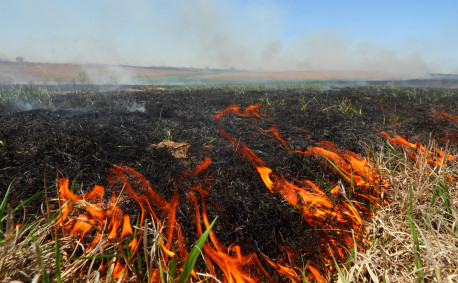Five Reasons Ranchers Burn Their Pastures
Did you know less than four percent of the original tallgrass prairie remains in America? Most of that is in the Flint Hills of Kansas. The prairie is composed of native grasses — not planted by any human. Even though it was designed by nature, it’s mankind's responsibility to help maintain and protect this incredible ecosystem. That’s where controlled burning comes in.
"If we want it to be here for the next generation, and the next generation, then we gotta do what Mother Nature did before we came here, and we've got to burn it quite often to keep the grassland a grassland." Mike Holder, Flint Hills Extension District (Mike is one of my heroes — an old cowboy who loves the prairie and isn't afraid to fight for it!)
You’re probably familiar with the practice, even if you don’t realize it. In early spring, the skies in Kansas often fill with smoke. Even people in metropolitan areas may experience hazy skies and smell smoke. Often, people with breathing problems have even more trouble at this time — on top of allergy season! So, why do ranchers set their grass on fire? Here are the top five reasons my family sets controlled fires on our prairie grass:
5. It Encourages Wildlife Population — What's Good for Livestock, Is Good for Wildlife!
Fire may seem destructive, but it actually preserves our unique prairie habitat. While it’s true our cattle benefit, so do many different species of birds and other wildlife.
"Fire is critical to prairie chickens and other grassland birds, because it keeps those trees out of the prairie. If you do not burn, you end up getting woody encroachment out into those grasslands and what that does is provide habitat ...for predators that prey upon prairie chickens and other grassland birds." Jim Pittman, Kansas Dept. of Wildlife, Parks and Tourism.
4. It Helps Control Weeds — And Kills Woody Shrubs and Trees.
Burning is a natural phenomenon — Mother Nature originally managed our prairie fires. Back when buffalo roamed free, lightning storms lit fires that raged over thousands of acres in one big bonfire. Once the grass began to regrow, the buffalo came to graze on the fresh, tender grass. The Native Americans noticed that fire also helped kill off the woody weeds and kept trees from invading the pristine prairie. So, they began lighting the first controlled burns and history was made! In addition to controlling weeds, burning the grass promotes diversity in the grassland. The beauty of the native prairie is that it isn't composed of only one plant. Many different grasses and forbs combine to make a healthy, sustainable grassland.
"The ranchers in eastern Kansas are really kind of stewards of one of the last pieces of the most important ecosystem in north America." Karl Brooks, EPA Region 7
3. It Promotes Better Utilization of Grasses by Livestock.
Cattle like to eat where it’s the easiest to get to grass, and as they eat, fresh tender grass regrows. There may be luscious, nutritious grass on the next hillside, but often cattle stay where they are content. So, they don't eat down the other hillside and the grass grows tall and lank there. It doesn't taste as good to them, and they ignore it. So, we burn off the lank, old grass to encourage fresh, tender and more nutritious grass to grow on that hill as well, which helps lure the cattle there. That’s better for the land, not just because there’s more to eat, but it also helps control erosion and compaction resulting from cattle walking all over the same land.
2. It Provides Better Food for Livestock with Fresh, Green, Nutritious Grass.
The Kansas Flint Hills are mostly cow country! Yes, there’s plenty of crop ground, but for the most part, the hillsides and tops are too rocky to farm. So, we manage the grass for cattle to use. Much of this land isn't fit to grow crops, so we bring nearly a million head of cattle here for a few months in the summer to eat the grass and turn it into something we humans can consume. Humans can't eat this grass, but cattle can and then they convert it to protein we can eat. Plus, it’s been proven that calves grow better on new, fresh grass like what grows after a burn.
1. It Uses Less Chemicals.
Mother Nature is amazing and constantly changing. One of the biggest reasons we have lost 96 percent of the native prairie is because it was either good enough land to grow crops, or it has become infested with trees. When an infestation of Eastern Redcedar (which would eventually happen without burning) engulfs a part of the prairie, we lose use of the land as well as the positive impacts of deep-rooted, carbon-sequestering native grasses. Without fire to control the woody invasion, we would have to turn to chemicals for widespread control. That not only increases expense, but also labor and safety.
Farmers and ranchers work closely with local authorities to determine the best times to burn their pastures for the safety of their communities and livestock. As caretakers of the land, farmers and ranchers are diligent about proper management for the health and wellbeing of their herds, their neighbors and all inhabitants of this amazing ecosystem.
"Fire is the only way to maintain it. It's too important an ecological asset to lose...." Brian Obermeyer, The Nature Conservancy.
This article appeared in partnership with Kansas Living and has been edited for our website. Read the full, original article by Debbie Lyons-Blythe on her blog Kids, Cows and Grass.


